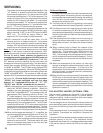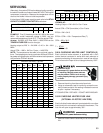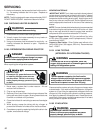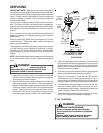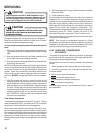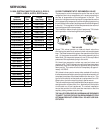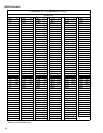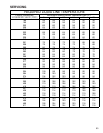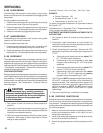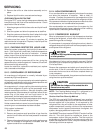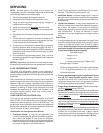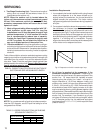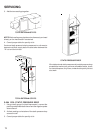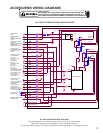
SERVICING
66
S-106 OVERFEEDING
Overfeeding by the expansion valve results in high suction
pressure, cold suction line, and possible liquid slugging of the
compressor.
If these symptoms are observed:
1. Check for an overcharged unit by referring to the cooling
performance charts in the servicing section.
2. Check the operation of the power element in the valve as
explained in S-110 Checking Expansion Valve Operation.
3. Check for restricted or plugged equalizer tube.
S-107 UNDERFEEDING
Underfeeding by the expansion valve results in low system
capacity and low suction pressures.
If these symptoms are observed:
1. Check for a restricted liquid line or drier. A restriction will
be indicated by a temperature drop across the drier.
2. Check the operation of the power element of the valve as
described in S-110 Checking Expansion Valve Operation.
S-108 SUPERHEAT
The expansion valves are factory adjusted to maintain 8 to 12
degrees superheat of the suction gas. Before checking the
superheat or replacing the valve, perform all the procedures
outlined under Air Flow, Refrigerant Charge, Expansion Valve
- Overfeeding, Underfeeding. These are the most common
causes for evaporator malfunction.
CHECKING SUPERHEAT
Refrigerant gas is considered superheated when its tempera-
ture is higher than the saturation temperature corresponding
to its pressure. The degree of superheat equals the degrees
of temperature increase above the saturation temperature at
existing pressure. See Temperature - Pressure Chart on
following pages.
CAUTION
To prevent personal injury, carefully connect and
disconnect manifold gauge hoses. Escaping liquid
refrigerant can cause burns. Do not vent refrigerant
to atmosphere. Recover during system repair
or final unit disposal.
1. Run system at least 10 minutes to allow pressure to
stabilize.
2. Temporarily install thermometer on suction (large) line
near suction line service valve with adequate contact and
insulate for best possible reading.
3. Refer to the superheat table provided for proper system
superheat. Add charge to lower superheat or recover
charge to raise superheat.
Superheat Formula = Suct. Line Temp. - Sat. Suct. Temp.
EXAMPLE:
a. Suction Pressure = 143
b. Corresponding Temp. °F. = 50
c. Thermometer on Suction Line = 61°F.
To obtain the degrees temperature of superheat, subtract
50.0 from 61.0°F.
The difference is 11° Superheat. The 11° Superheat would fall
in the ± range of allowable superheat.
SUPERHEAT AND SUBCOOLING ADJUSTMENT ON TXV
APPLICATIONS
1. Run system at least 10 minutes to allow pressure to
stabilize.
2. Temporarily install thermometer on liquid (small) line
near liquid line service valve with adequate contact and
insulate for best possible reading.
3. Check subcooling and superheat. Systems with TXV
application should have a subcooling and superheat of
7 ± 2ºF.
a. If subcooling and superheat are low, adjust TXV
to 7 - 9ºF then check subcooling.
b. If subcooling is low and superheat is high, add
charge to raise subcooling to 7 ± 2ºF then check
superheat.
c. If subcooling and superheat are high, adjust TXV
valve to 7 ± 9ºF then check subcooling.
d. If subcooling is high and superheat is low, adjust
TXV valve to 7 to 9ºF superheat and remove
charge to lower the subcooling to 7 ± 2ºF.
The TXV should NOT be adjusted at light load conditions
55º to 60ºF, under such conditions only the subcooling
can be evaluated. This is because suction pressure is
dependent on the indoor coil match, indoor airflow, and
wet bulb temperature. NOTE: Do NOT adjust charge
based on suction pressure unless there is a gross
undercharge.
4. Disconnect manifold set. Installation is complete.
S-109 CHECKING SUBCOOLING
Refrigerant liquid is considered subcooled when its tempera-
ture is lower than the saturation temperature corresponding
to its pressure. The degree of subcooling equals the degrees
of temperature decrease below the saturation temperature at
the existing pressure.
1. Attach an accurate thermometer or preferably a thermo-
couple type temperature tester to the liquid line as it
leaves the condensing unit.
2. Install a high side pressure gauge on the high side (liquid)
service valve at the front of the unit.
3. Record the gauge pressure and the temperature of the
line.



